The Udumbara has been discussed in religious communities throughout the ages. Those who have seen these reputedly near-microscopic flowers in real life are awestruck by their fragile-yet-resilient beauty, and those who haven’t come across them dismiss them as just a myth or as insect eggs. But whatever the truth may be, the Udumbara has reportedly been sighted in several places worldwide in the last couple of decades.
Udumbara is a word from Sanskrit, an ancient Indian language, meaning an “auspicious flower from heaven.” It’s said that their fragile, silky stalks and translucent bell-like petals are so tiny that one marvels at chancing upon them. These mysterious flowers are also known for thriving for a long time, even persisting for over a year.






